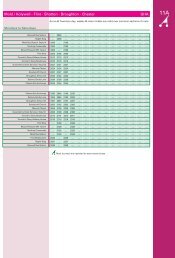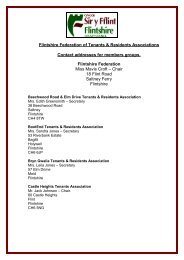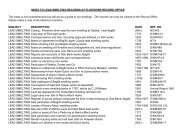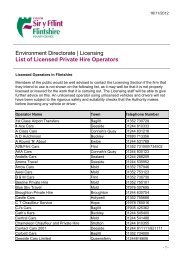Caerwys Eng.indd - Flintshire County Council
Caerwys Eng.indd - Flintshire County Council
Caerwys Eng.indd - Flintshire County Council
Create successful ePaper yourself
Turn your PDF publications into a flip-book with our unique Google optimized e-Paper software.
Maesmynan Hall, near the<br />
site of the Medieval palace<br />
A centre for trade<br />
and commerce<br />
For centuries <strong>Caerwys</strong> was an important administrative and<br />
commercial centre in the region. It first gained importance<br />
in the 11th century due to its association with the Princes<br />
of Gwynedd. Prince Gruffyd ap Cynan married a local lady<br />
and had a palace at Maesmynan. His successors, Llywelyn ap<br />
Grufydd (Llywelyn the last), and his brother, Prince Dafydd,<br />
continued to use Maesmynan until their defeat by Edward I.<br />
In 1244, the Pope chose <strong>Caerwys</strong> church as the meeting place<br />
for two abbots to decide a dispute between Prince Dafydd<br />
and King Henry III, which reflects its importance at that time.<br />
A stone effigy, claimed to be of Dafydd’s wife, Elizabeth Ferrers,<br />
still lies in <strong>Caerwys</strong> church.<br />
The town’s importance as a trading centre grew as the nearby Norman<br />
settlements of Flint and Rhuddlan developed and Basingwerk Abbey<br />
became increasingly influential. It was also well placed for cross border<br />
trading with Chester.<br />
<strong>Caerwys</strong> was already an established Welsh settlement when Edward I<br />
granted it a Royal Charter in 1290. This meant it was very different<br />
from the other North Wales charter towns, which were newly-built fortified<br />
towns where trading rights were only granted to <strong>Eng</strong>lish immigrants. The<br />
local Welsh were forbidden to trade and discouraged from living within the<br />
<strong>Eng</strong>lish towns. In <strong>Caerwys</strong>, some of the Welsh were free burgesses with a<br />
merchant guild and equal trading rights to their <strong>Eng</strong>lish overlords.<br />
Artists impression of the market hall<br />
By 1292, 39 of the 42 taxpayers had Welsh<br />
names, whereas Flint only had five and<br />
Rhuddlan one! It was during this period that <strong>Caerwys</strong><br />
was laid out in the grid pattern that remains to this day.<br />
In 1351 it was granted a second charter, making it a Municipal Borough,<br />
and, in 1356 granted permission to hold a weekly market and two annual<br />
fairs. Until the late 17th century <strong>Caerwys</strong> was one of the main towns in<br />
<strong>Flintshire</strong>, where the Assize Courts and markets were held.









